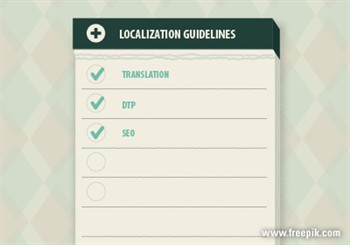Content Strategy: Auditing for Localization
In my previous blog post on Content Strategy: Content Audits, I explained how important having a content strategy is to producing high-quality, reusable and consistent English and translated content. I also explained that a content audit is a step towards putting a content strategy in place. In general, a content audit consists of an inventory, which is a record of the volume of content you’re focusing on, and a qualitative analysis of that content, which is an evaluation of the content for a variety of measures depending on your business goals.

Today I’ll focus on auditing content for localization. If you have a global content project, such as translation of technical documents, marketing collateral or training materials, or you have a website globalization project, you should audit the content for criteria related to localization. You should also audit for other criteria (e.g., quality, consistency, structure, etc.) as I’ve talked about in previous blog posts, but there are specific localization measures that should be addressed before translation.
By auditing for localization, you improve consistency and appeal to your customers, you save on translation costs by sending less content to translation and using more repeatable words, and reduce time to market.
Ideally you should put localization guidelines in place before you start a project to minimize the time required at the end. However, if your project is already underway, it’s still important to audit your content before sending it translation to avoid paying for exponential errors and delays. For example, let’s say you have ten errors in your English content and you plan to translate the content into ten languages. If you don’t catch these errors prior to translation, you’ll pay to fix 100 errors and face potential project delays.
Either way, you can create localization guidelines along the way to use during the project or on your next project.
Content Inventory
An inventory is a representation of the quantity of content you’re analyzing, which could be many things depending on your area of focus, business goals and scope of work.
If your project is already underway, you know the scope of the work (e.g., a brochure, an installation manual or a website) and you won’t need to do a content inventory. However, if you’re looking at a single document and you have more of those types of documents, such as a brochure set, you may want to consider expanding the audit scope to include those documents as well.
If your project isn’t underway, consider looking at similar content during the audit. Anyone with a stake in the content can create the inventory and you can track it using a spreadsheet.
If you don’t have enough resources or budget to include additional content now, create localization guidelines as you go through the process and then consider auditing the content when you do have resources and a budget.

Qualitative Audit
If your project is underway, you’ll want to define localization criteria and then audit the content. Here are some examples of things to consider auditing:
- Writing guidelines: clear, active voice, direct, no jargon, room for translated content
- Terminology: product terminology, industry terms, consistency with common words or phrases like “refer to” and “look at”
- Structure: content sections, contact information, layout
- Cultural sensitivity: images, colors
- Graphic design and structure: text separate from graphic, imperial and metric units
- Data formats: dates, time, telephone numbers, measurements
- SEO: keywords, metadata, videos translated
Once you’ve determined your set of criteria, create a spreadsheet (or another format) or multiple spreadsheets depending on the scope to document the findings. Some things you can correct as you do the audit, such as telephone number formats. You’ll want to capture the general corrections though in order to add it to the guidelines. Here are a few examples of how to audit criteria:
- Terminology: pick a term, like a product name, and search the content; then review the content for other instances of this term. Record the variations in the spreadsheet.
- Graphic design and structure: review each graphic to verify text is separate, and both imperial and metric units are present (if applicable).
- Data format: review the content for all locations of phone numbers and check for consistency in the formatting and the numbers themselves. Add the approved style to the guidelines.
Next Steps
Once you’ve completed the audit, review the results with your team. With your business goals in mind, look for patterns in the data, gaps between current and future state, and other measures. Make actionable, measurable recommendations based on the data along with pros and cons of each one and then present your findings to your key stakeholders. You can use this data to build your localization guidelines.

Localization Guidelines
If you haven’t started your global project, you can define criteria that are important to the project and then establish localization guidelines to follow throughout development. In this case, you shouldn’t have any additional work to do at the end which should save time overall.
If your project is already underway, you can create localization guidelines to use on your next project and you’ll be ahead of the game.
As you add content to your project, you’ll want to continue to audit the new content. If you have similar content sets, you can audit them using the localization guidelines.
Conclusion
Auditing for localization before sending content to translation results in more reusable and consistent English and translated content while also saving money. Conducting an inventory (if needed), auditing for criteria and then analyzing the findings is important to an overall marketing strategy.
Resources for Content Localization and Content Strategy
You may gain further insight into content strategy, content localization, translations and related topics by reviewing previous blogs written by GPI:
